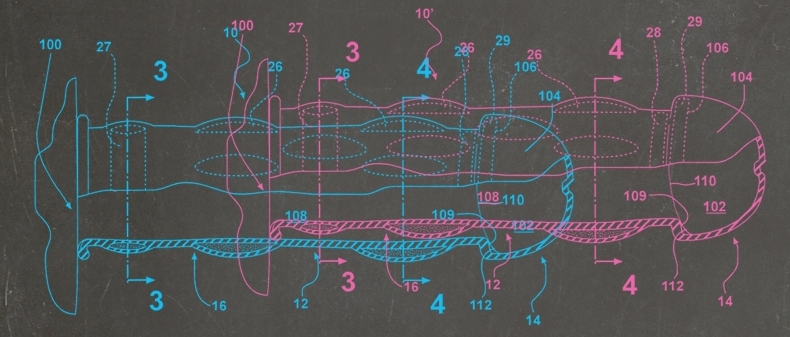
image: condom patent from strutpatent.com
“As long as I can yell ‘Science!’ when I come.”
I enlisted my partner of 16 years to help with an experiment. I needed to test a FC2, the female condom made by the Female Health Company. I had never used one before, and I don’t know anyone who has ever admitted to using them. Let’s just say that it felt just as good as I imagine a Ziploc filled with lube would feel.
Condoms are both marvelous and horrible things. What they can do in the name of prevention is revolutionary, but that revolution train stopped quite a few years ago.
Condoms for dicks (unlike the FC2) have been around in some form or another for hundreds of years, with most early records coming from Europe. They’ve been made using various materials with varying degrees of efficacy. In the fifteenth century, there were ‘glans condoms,’ sheaths that only covered the head of the penis (how the hell did they stay on?). Some were made of animal intestines, some of oiled paper, some even from bone or tortoise shell (Ow. Ow. Ow.). The sixteenth century saw chemically treated linen sheaths, tied with a ribbon. In the seventeenth century, the Dutch were using fine leather (I’m intrigued).
By the eighteenth century, there was growing condemnation of the use of these prophylactics on medical, moral, and/or religious grounds. Some strident feminists were opposed to condom use, angered by the thought that contraception should become male-controlled. The church hated (still does) “unnatural means of conception avoidance.” Some physicians refused to treat syphilis patients, believing they got what they deserved.
By the time the nineteenth century rolled around, the manufacture, sale, and/or advertisement of (now mostly rubber) condoms experienced restrictions in some form or another around the world. The Comstock Laws, put into effect in the US to restrict obscene materials, criminalized the mailing of any contraceptive device, or related informational materials (as well as anything about abortion). This, combined with moralist interference and lack of proper sex education in schools, is said to be responsible for the Americans’ enormous rise in STIs in the second half of the century .
Despite all the bullshit surrounding condom use, military leaders from various countries started distributing ‘rubbers’ to their soldiers, and in response, saw a decrease of STIs among them. But civil populations were treated differently, and restrictions abounded, from legally marketing condoms only as ‘disease prevention’ (and not as contraception) to completely criminalizing their use because of low birth rates.
During the twentieth century, latex started replacing rubber for its easier manufacture and reduction of thickness. Quality controls became common (with some factories selling their rejected batches to foreign markets. Classy). When the eighties hit with the first signs of AIDS, both condom promotion and use rose, and has continued to climb ever since.
Through all these battles, the design of the male condom never really changed, with improvements to no more than the materials and efficacy. From paper to linen to rubber to latex, the shape only really saw an expansion in length and reduction in thickness. The changes to options have been modest, with ridges or bumps added for ‘pleasure,’ colour, or flavour. The female condom was introduced in the nineties, but never gained the popularity seen by its male counterpart, probably due to cost (mine was $3.50), discomfort in use, and a certain skill needed to insert it properly. There aren’t many in production and it’s none too sexy to look at once inserted.
So the overall shape and delivery method of the conventional condom have maintained a status quo of the uninspired: rolled up in a flat packet.
Though they have their advantages – cheap, effective, portable, all participants can be responsible for them – condoms are still a bit of a pain to buy (stigma still exists and selection can be limited in certain spots. Ever try finding a vegan condom at a gas station?), they can be difficult to break open and unwrap quickly or one-handed, they taste terrible, they limit sensation for the user and can cause pain for the usee, and seeing a spent condom discarded on the sheets is enough to break the magic of the night before. Read: I hate them.
So, why, after the revolution of their initial creation, has the technology not advanced past packet colours and luminosity? For most manufacturers, it’s a story of not fixing something that ain’t broke. Why try to revolutionize something that keeps making profit in its current incarnation? I’m convinced male condom manufacturers don’t actually use condoms, none of them have latex allergies, and none of them are women.
There have been a handful of stabs at trying to shake up the condom industry with some innovative challenges to the usual. South African design firm XYZ created the 4Secs, a condom applicator that takes the guesswork out of which side is up, as well as awkward unraveling.
There’s also the ‘one-handed wrapper,’ created as a part of a project studying hemiplegia. In trying to eliminate the awkwardness of condom use by someone experiencing semi-paralysis of the hands, this quick snap of the package by two fingers reveals the condom easily, face down and ready for unrolling.
Though these exhibit ingenuity, they don’t target the design of the condom itself, only the distribution system. We’re still left with the too-tight, foul-tasting (and smelling), insensitive sheath.
Origami Condoms is a redesign of the current condom (both male and female) that may revolutionize the staid industry. It’s causing quite the stir as the “first non-rolled, injection-molded, engineered, silicone condom.” They’re in proto stages now and looking at availability in 2015.
Taking things a step further, researchers at the University of Washington are experimenting with a nanofabric “designed to dissolve in the body, releasing preventative drugs” that can safeguard against both STIs and pregnancy. I’m keeping my eyes on that one.
Despite these breakthroughs in delivery & design, the condom is still in need of some serious changes. Bill and Melinda Gates also seem the think so, whose foundation recently introduced the next round of its Grand Challenges Explorations, including the hunt for the “next generation condom that significantly preserves or enhances pleasure to improve uptake and regular use.” If your design meets specific criteria, you could receive a $100,000 grant for further development. If there was ever an incentive to improve on a design, it’s this one.
In my lifetime alone, I’ve seen NASA-sized computing power shrink to the palm of my hand, artificial organs save lives, and robots sweep floors. I’m not even that old. Enjoyable safe sex really shouldn’t be so hard to achieve. Until then, I’ll have to suck it up and enjoy The Man yelling “Science!” in the name of experimental testing, which really isn’t so bad.
***
After some polling of sex-friendly peeps, I’ve culled a list of some favourite raincoat options:
Lifestyles Skyn: In thinking I may have a latex allergy due to burning sensations after condom use, these are my new faves. Thin and latex-free (made from polyisoprene).
Sir Richards: A close second, they’re comfortable and vegan-certified.
Kimono: These were my and my partner’s condom of choice before discovering the above two. Nice and thin.
Crown: I haven’t tested these, but my polling revealed these to be a good contender.
If you want to try the female condom (just because I didn’t like it doesn’t mean you won’t), I’ve heard Durex offers a good one.
____
Got a question about sex in art, relationships, parenting? Send Sonya a note at dearmadame@torontostandard.com. Anonymity assured.
Sonya JF Barnett, also known as “The Madame,” is the founder of an erotic arts community called The Keyhole Sessions and the co-founder of SlutWalk Toronto. Follow her on Twitter @KeyholeSessions.
For more, follow us on Twitter @TorontoStandard and subscribe to our newsletter.














